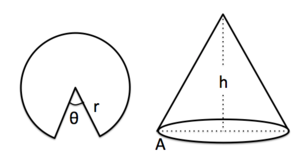Course:MATH102/Question Challenge/2001 December Q9
| Questions? Click here to add or read comments for this problem | |
| Please rate how easy you found this problem:
{{#w4grb_rate:}} Hard Easy | |
|---|---|
Question
A wedge-shaped region is cut out of a circle of fixed radius and the cut edges are joined to produce a cone, as shown in the figure. The remaining part of the circle's perimeter, whose length is forms the bottom edge of the cone. For what angle is the volume of the resulting cone greatest?
Recall that the volume of a cone is where is the radius of the base of the cone.

Hints
| Hint 1 |
|---|
| You are given the length of the perimeter of the cone's base. Use that information to write down the radius of that base. |
| Hint 2 |
|---|
| A slice through the axis of the cone is a triangle. Relate the height and base radius of the cone to the radius of the original circle. |
Solutions
| Solution |
|---|
| radius of the circle = constant
θ = the angle formed by cutting out a section of the circle; we must optimize this to produce the largest possible volume for the cone For the Pythagorean triangle seen in the cross section of the cone: , where is the radius of the circle, is the radius of the base of the cone, and is the height of the cone. This relationship is a constraint. and are variables dependent on θ. The volume of the cone is given by: Rearrange the constraint to: We can substitute this into the equation for volume to obtain: . (Note that since is constant, is now a function of just one variable, .) This simplifies to: We obtain the derivative of this function and equate it to zero to maximize the volume:
To check that this is in fact a maximum we take the second derivative and substitute in our or critical point for :
Since is a positive value, the second derivative must be negative for this value of h. This proves that we have found a maximum. Now we want to find the cone's base radius, . Substituting in for into the equation for the cross-section of the cone we find:
We are told that: the circumference of the base of the cone Therefore: Substituting in the R we know gives the cone of maximum volume we find:
θ = 1.15 rad = 66.06 degrees |




























